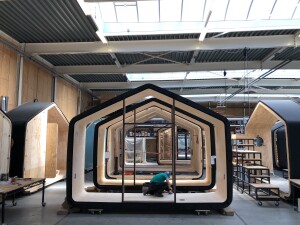
University of Illinois at Urbana-Champaign researchers have completed a study on climate change that predicts the temperature in certain urban areas will, on average, increase between 1.9°C and 4.4°C by the end of the century. By combining a process-driven physical climate model with a data-driven statistical model emulating climate change for 26 different urban areas, the researchers predicted that cities will also experience an overall decrease in humidity, "making surface evaporation more efficient and implying that adaptation strategies like urban vegetation could be useful," according to a university press release. In their Nature publication, the researchers explain that the "findings highlight the critical need for multi-model global projections of local urban climates for climate-sensitive development and support green infrastructure intervention as an effective means of reducing urban heat stress on large scales." [University of Illinois Urbana Champaign]

What innovative technologies can the building sector expect in 2021? ARCHITECT asks 12 design and technology thought leaders across the country to predict what the new year will bring. [ARCHITECT]
Amazon has pledged $2 billion to affordable housing in its Arlington, Va., Nashville, Tenn., and Seattle employment hubs, according The Wall Street Journal. The retail giant will channel the majority of its investment into low-cost loans to preserve existing or build new affordable housing, ensuring the presence of more than 20,000 units for individuals making between 30% and 80% of each metro area's average income. Some of the funds will serve as grants to minority-led housing developments. [WSJ]

Tasked with reimagining the global headquarters of tiremaker Goodyear in Akron, Ohio, Gensler and Cleveland-based Vocon looked to the company's past for inspiration. ARCHITECT's latest Project 360 interactive feature tells the story of how architects captured Goodyear's past, present, and future all while supporting environmental stewardship and employee health and wellness. [ARCHITECT]
We’ve developed two neural networks which have learned by associating text and images. CLIP maps images into categories described in text, and DALL-E creates new images, like this, from text.
— OpenAI (@OpenAI) January 5, 2021
A step toward systems with deeper understanding of the world. https://t.co/rppy6u1zcn pic.twitter.com/MNVlo8LZbV
The San Francisco–based research hub OpenAI has launched DALL·E and CLIP, two new artificial intelligence–comprehension models that combine images and the written word. OpenAI tested the AI models with fantastical prompts such as “an armchair in the shape of an avocado," and seeing how the program generates an imaginative range of possibilities for avocado-shaped armchairs. Will Douglas Heaven, the senior editor for AI at MIT Technology Review, dives into the future of a language- and image-based AI. [MIT Technology Review]
Boston Dynamics construction manager Brian Ringley recently wrote that robotics could transform the role of architects through their data-capture abilities, but he failed to add that his company's own robotics have upped their dance moves. In a video posted to celebrate the new year, BD robots Atlas, Spot, and Handle shimmy to The Contours crooning "Do You Love Me?", bringing much-needed smiles in the new year. The video has more than 24 million views to date. BD's vice president of engineering Aaron Saunders subsequently explained to IEEE how his team taught the robots their moves. [IEEE]
Building on its previous collaborations with fashion designer and artist Virgil Abloh, bottled water brand Evian has offered a sneak peek of its upcoming collaboration. Abloh, named the brand's creative adviser of sustainable innovation design in 2018, described the design in a post on Evian's Instagram, explaining that he "wanted to create a shape that was as iconic as the Evian brand, whilst representing how the product has been reinvented using old bottles."

Based on the United Nations’ Intergovernmental Panel on Climate Change, the global carbon budget was 340 GtCO₂ as of Jan. 1, 2020, in order to limit worldwide warming to 1.5°C. One year later, learn how architects can help stay within budget to mitigate the impacts of climate change in Architecture 2030 founder Edward Mazria, FAIA's latest CarbonPositive column. [ARCHITECT]
Cardboard has become so ubiquitous that seeing its architectural potential might take a set of fresh eyes. Columnist Blaine Brownell, FAIA, dives into the humble material's architectural history and sustainable attributes. [ARCHITECT]
From grand Classical memorials to simple tombstones, monuments have an architectural history of their own. This month, the Building Technology Heritage Library's Mike Jackson digs into its historical collection of popular memorials and monuments designs of the past. [ARCHITECT]















